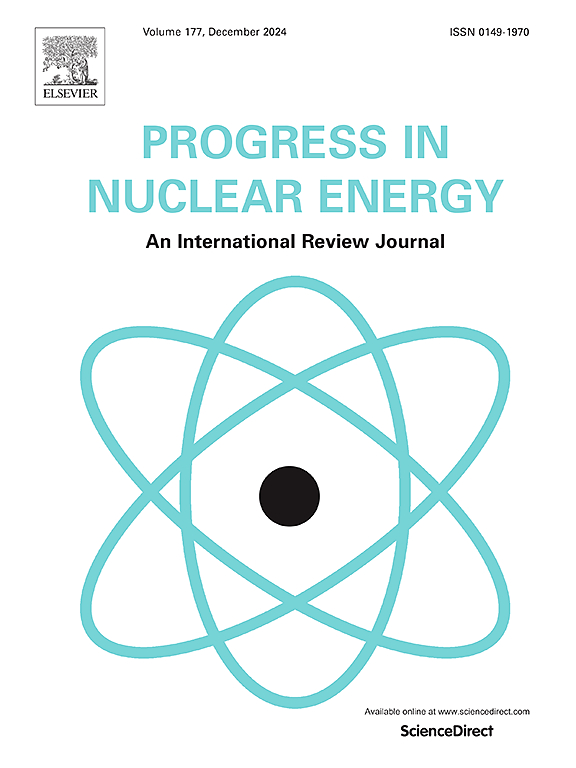Optimizing exergy efficiency in the Bushehr WWER-1000 nuclear power plant using Multi-Verse Optimization algorithm
IF 3.3
3区 工程技术
Q1 NUCLEAR SCIENCE & TECHNOLOGY
引用次数: 0
Abstract
Exergy analysis and optimization methods are essential for evaluating thermal energy processes in power plants. This study aims to optimize the thermal efficiency of a nuclear power plant (NPP) using the exergy method. In this work, the energy and exergy analysis of the Bushehr Nuclear Power Plant (BNPP) are assessed, followed by an exploration of various optimization algorithms in conjunction with the first and second laws of thermodynamics. By employing advanced computational techniques, overall plant performance is improved. Using algorithms such as Multi-Verse Optimization (MVO), Arithmetic Optimization Algorithm (AOA), Bird Swarm Algorithm (BSA), Salp Swarm Algorithm (SSA), Marine Predators Algorithm (MPA), Flow Direction Algorithm (FDA), and Whale Optimization Algorithm (WOA), the thermal efficiency of the BNPP is improved from 33.6 % to 36.44 %, 36.42 %, 35.486 %, 35.48 %, 35.42 %, 35.464 %, and 35.385 %, respectively. The average results over ten runs indicate an exergy ranking of MVO < AOA < BSA < SSA < MPA < FDA < WOA. Results show that main equipment, such as the reactor, steam generator, and reactor coolant pumps, exhibited constant irreversibility. In contrast, other components, including the low-pressure turbine (LPT), re-heater, deaerator, condensate pump, and High-Pressure Heater 1 (HPH1), demonstrated increasing in irreversibility, and totally the irreversibility was reduced entire the plant.
利用多元宇宙优化算法优化布什尔WWER-1000核电站的火用效率
火用分析和优化方法是评价电厂热能过程的关键。本研究旨在利用火用法优化核电厂的热效率。在这项工作中,对布什尔核电站(BNPP)的能量和火用分析进行了评估,然后结合热力学第一定律和第二定律探索了各种优化算法。通过采用先进的计算技术,提高了工厂的整体性能。采用多verse优化算法(MVO)、算法优化算法(AOA)、鸟群算法(BSA)、Salp Swarm算法(SSA)、海洋掠食者算法(MPA)、流向算法(FDA)和鲸鱼优化算法(WOA)等算法,BNPP的热效率分别从33.6%提高到36.44%、36.42%、35.486%、35.48%、35.42%、35.464%和35.385%。十次运行的平均结果表明MVO <;AOA & lt;BSA & lt;SSA & lt;MPA & lt;FDA & lt;WOA。结果表明,反应堆、蒸汽发生器和反应堆冷却剂泵等主要设备表现出恒定的不可逆性。相比之下,包括低压涡轮(LPT)、再加热器、除氧器、冷凝泵和高压加热器1 (HPH1)在内的其他部件的不可逆性增加,整个工厂的不可逆性总体上降低了。
本文章由计算机程序翻译,如有差异,请以英文原文为准。
求助全文
约1分钟内获得全文
求助全文
来源期刊

Progress in Nuclear Energy
工程技术-核科学技术
CiteScore
5.30
自引率
14.80%
发文量
331
审稿时长
3.5 months
期刊介绍:
Progress in Nuclear Energy is an international review journal covering all aspects of nuclear science and engineering. In keeping with the maturity of nuclear power, articles on safety, siting and environmental problems are encouraged, as are those associated with economics and fuel management. However, basic physics and engineering will remain an important aspect of the editorial policy. Articles published are either of a review nature or present new material in more depth. They are aimed at researchers and technically-oriented managers working in the nuclear energy field.
Please note the following:
1) PNE seeks high quality research papers which are medium to long in length. Short research papers should be submitted to the journal Annals in Nuclear Energy.
2) PNE reserves the right to reject papers which are based solely on routine application of computer codes used to produce reactor designs or explain existing reactor phenomena. Such papers, although worthy, are best left as laboratory reports whereas Progress in Nuclear Energy seeks papers of originality, which are archival in nature, in the fields of mathematical and experimental nuclear technology, including fission, fusion (blanket physics, radiation damage), safety, materials aspects, economics, etc.
3) Review papers, which may occasionally be invited, are particularly sought by the journal in these fields.
 求助内容:
求助内容: 应助结果提醒方式:
应助结果提醒方式:


